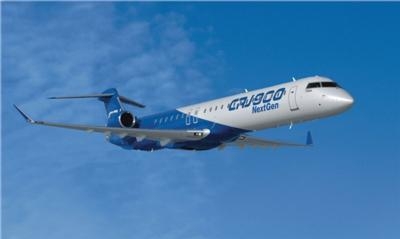Tue, Nov 14, 2017
Expects 450 New 60- To 150-Seat Aircraft To Boost Middle East Regional Connectivity Over The Next 20 Years
Bombardier Commercial Aircraft's Market Forecast 2017-2036 covering the 60 to 150-seat segment sees growth in the Middle East with expected delivery of 450 aircraft in that market segment, or four per cent of the forecast 12,550 deliveries worldwide with a total value of $820 billion.

The large regional aircraft category (60-100 seats) will account for 200 deliveries, while the small single-aisle category (100-150 seats) will take 250 aircraft. This will result in a fleet 3.4 times larger than at present.
"We are well positioned to take advantage of a move to strict capacity management in the region," said Jean-Paul Boutibou, Vice President, Sales, Middle East and Africa, Bombardier Commercial Aircraft. "Our Q400 high-speed turboprop, CRJ700, 900 and 1000 regional jets and new C Series small single-aisle jets can meet any requirement from 60 to 150 seats with unbeatable performance, economics and efficiency. We are the only aircraft manufacturer with that capability and we look forward to working with Middle East airlines as they expand their intra-regional networks."
The Forecast says that although Middle East airlines were profitable in 2016, the trend is downward. Double-digit capacity increases in the last two years to gain market share were achieved at the expense of decreasing yields due to the emergence of low-cost carriers in the region. The U.S. attempts to curb air travel from some Middle East countries has also put pressure on the region's widebody driven business model. This will result in a slowdown of widebody aircraft deliveries.
Middle East airlines now have an opportunity to re-examine and re-balance their fleet mix in order to develop intra-regional connectivity which has been largely bypassed in favor of inter-regional networks, to fit demand to capacity. Right-sizing of the fleet will lead to higher intra-regional market and penetration and improve yields, the forecast says.
(Source: Bombardier news release. Image from file)
More News
Takeoff Roll The process whereby an aircraft is aligned with the runway centerline and the aircraft is moving with the intent to take off. For helicopters, this pertains to the act>[...]
“We’re proud of the hard work that went into receiving this validation, and it will be a welcome relief to our customers in the European Union. We couldn’t be mor>[...]
"Aircraft Spruce is pleased to announce the acquisition of the parts distribution operations of Wag-Aero. Wag-Aero was founded in the 1960’s by Dick and Bobbie Wagner in the >[...]
IDENT Feature The special feature in the Air Traffic Control Radar Beacon System (ATCRBS) equipment. It is used to immediately distinguish one displayed beacon target from other be>[...]
Aero Linx: Pararescue Air Force Pararescuemen, also known as PJs, are the only DoD elite combat forces specifically organized, trained, equipped, and postured to conduct full spect>[...]
 ANN's Daily Aero-Term (05.10.24): Takeoff Roll
ANN's Daily Aero-Term (05.10.24): Takeoff Roll Aero-News: Quote of the Day (05.10.24)
Aero-News: Quote of the Day (05.10.24) Aero-News: Quote of the Day (05.11.24)
Aero-News: Quote of the Day (05.11.24) ANN's Daily Aero-Term (05.11.24): IDENT Feature
ANN's Daily Aero-Term (05.11.24): IDENT Feature ANN's Daily Aero-Linx (05.11.24)
ANN's Daily Aero-Linx (05.11.24)



